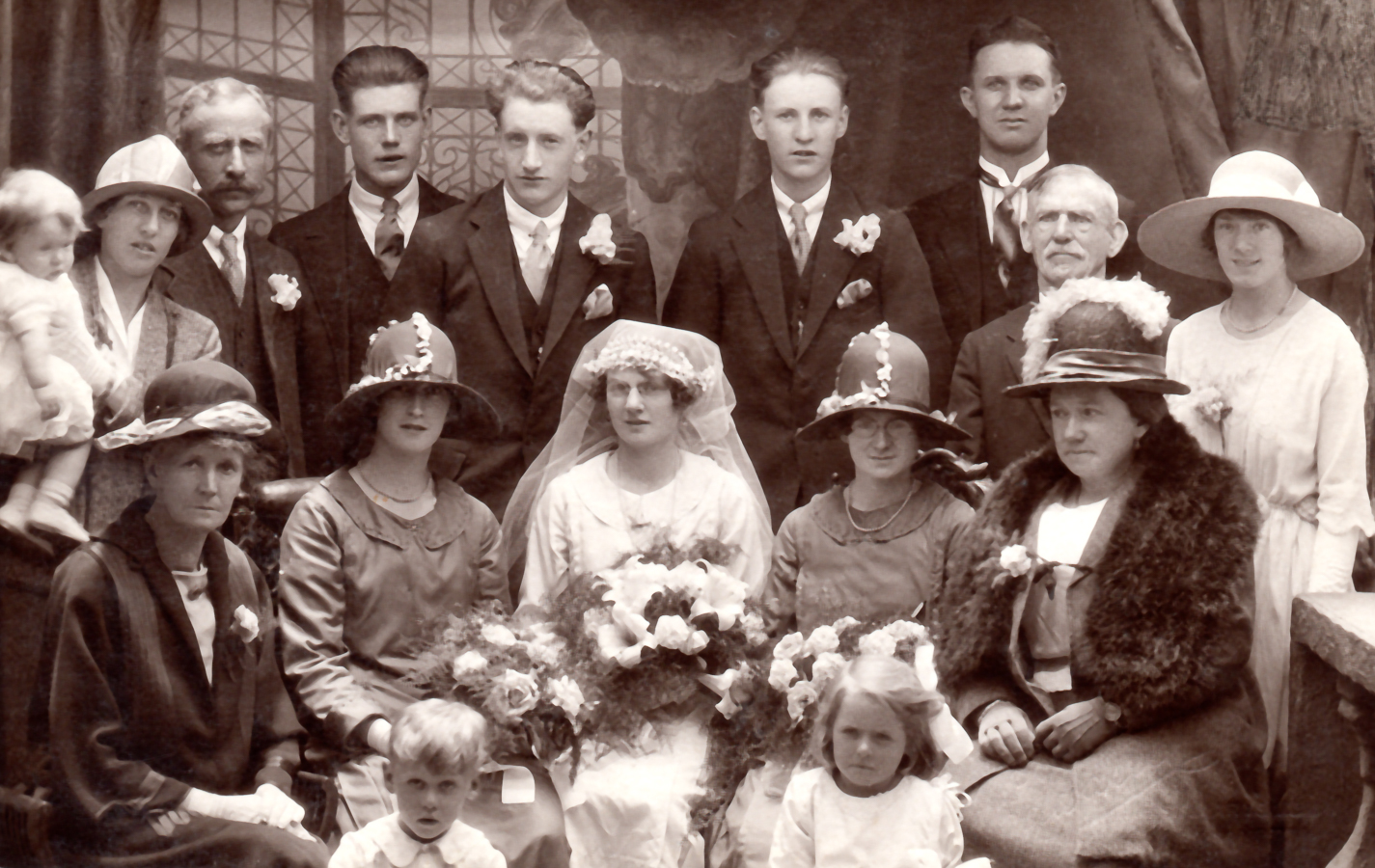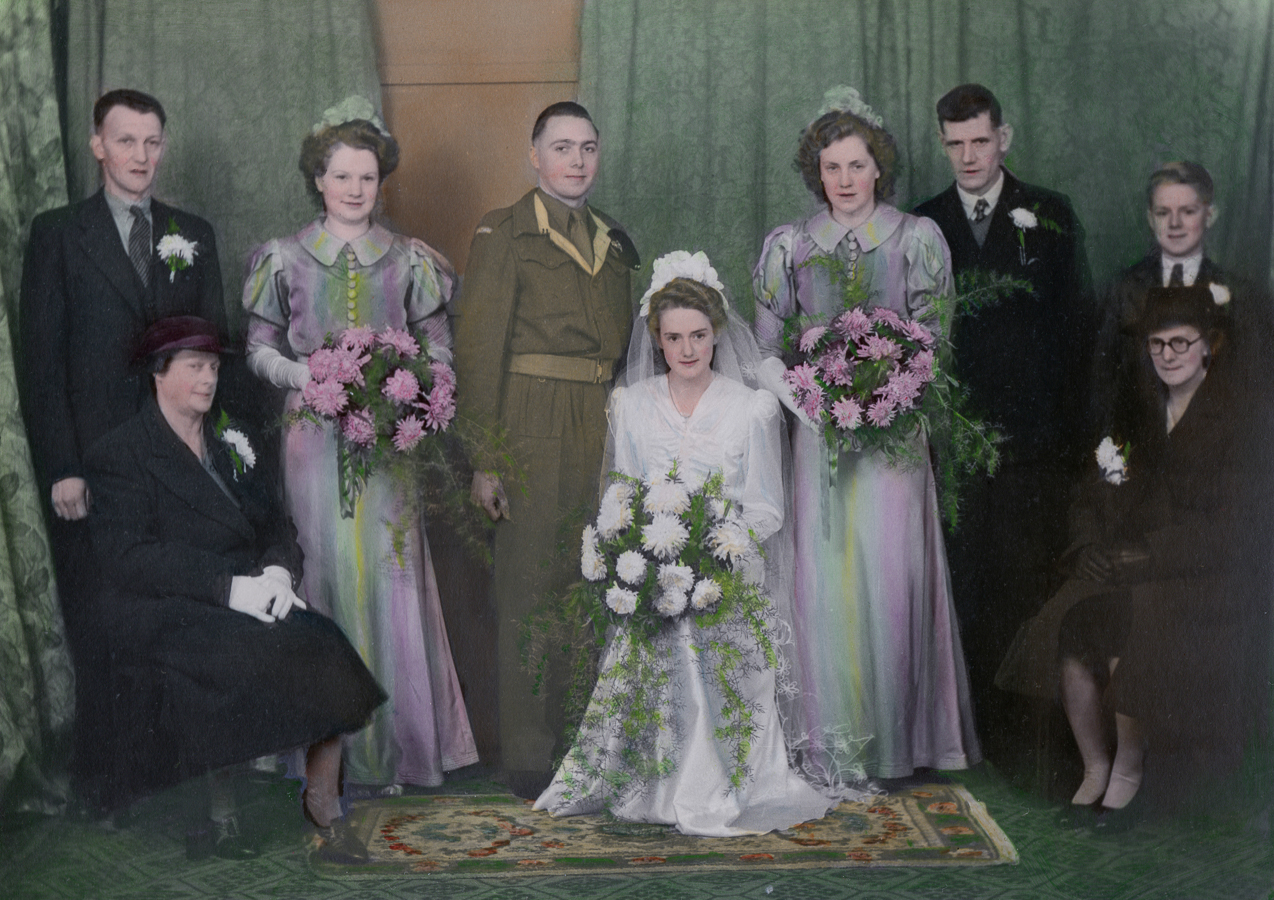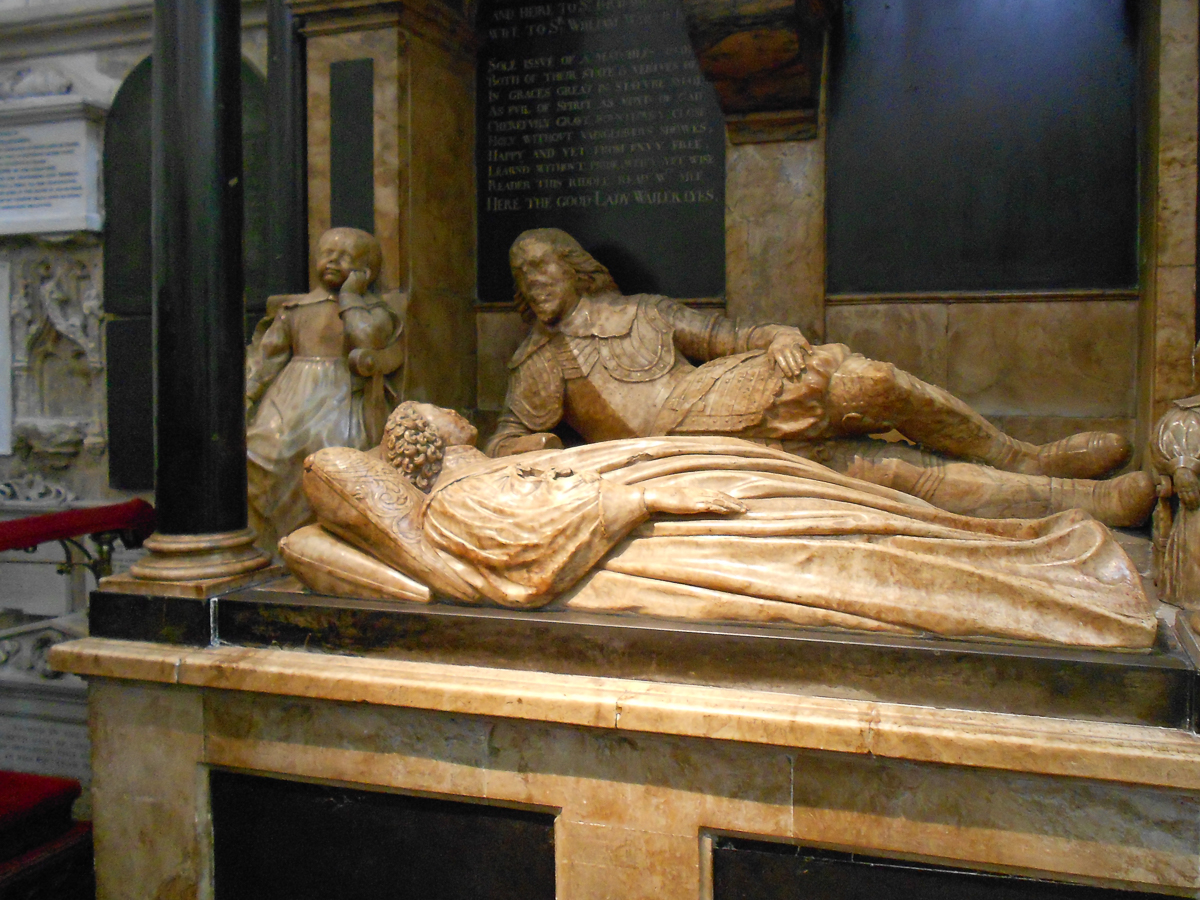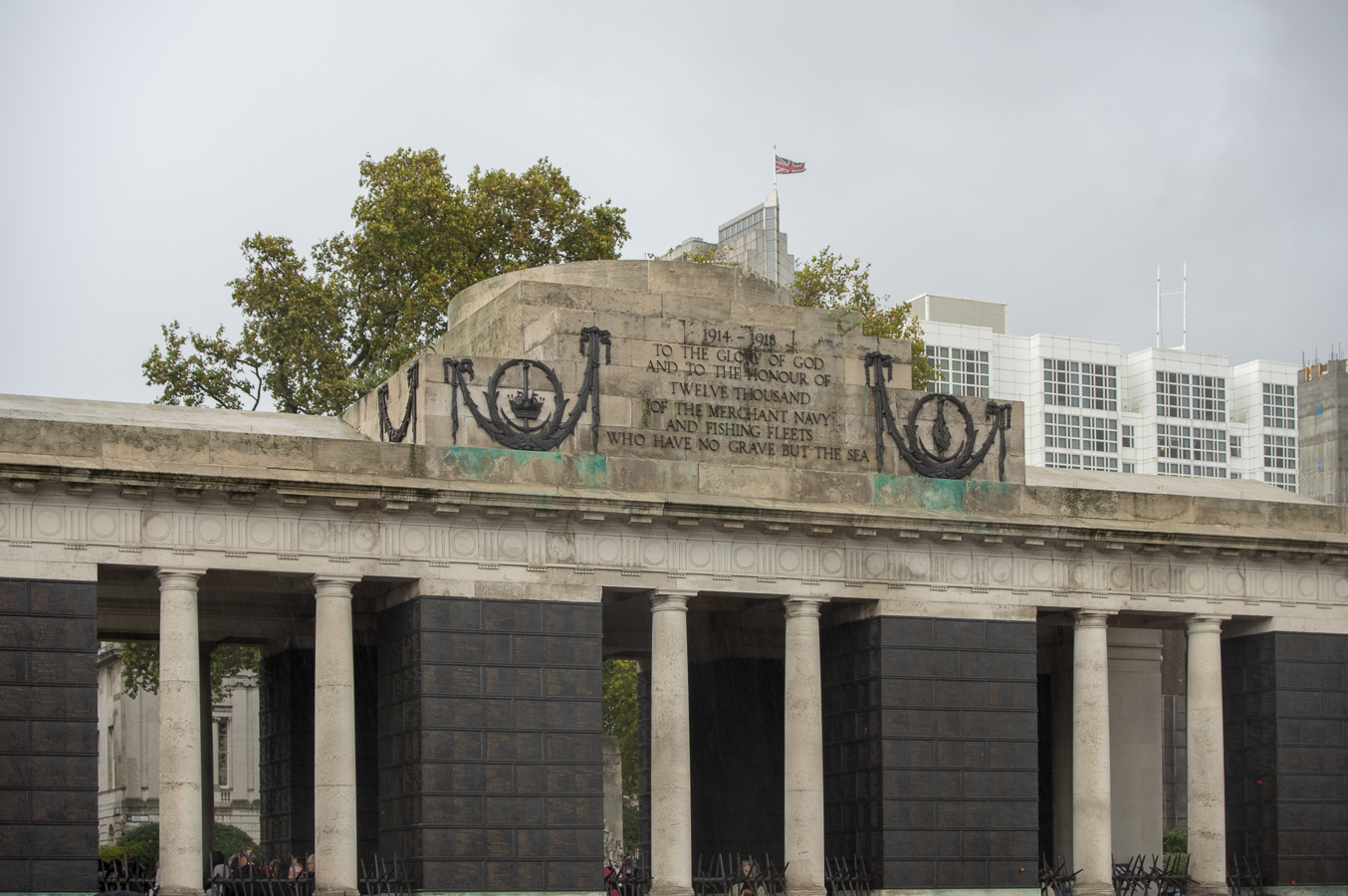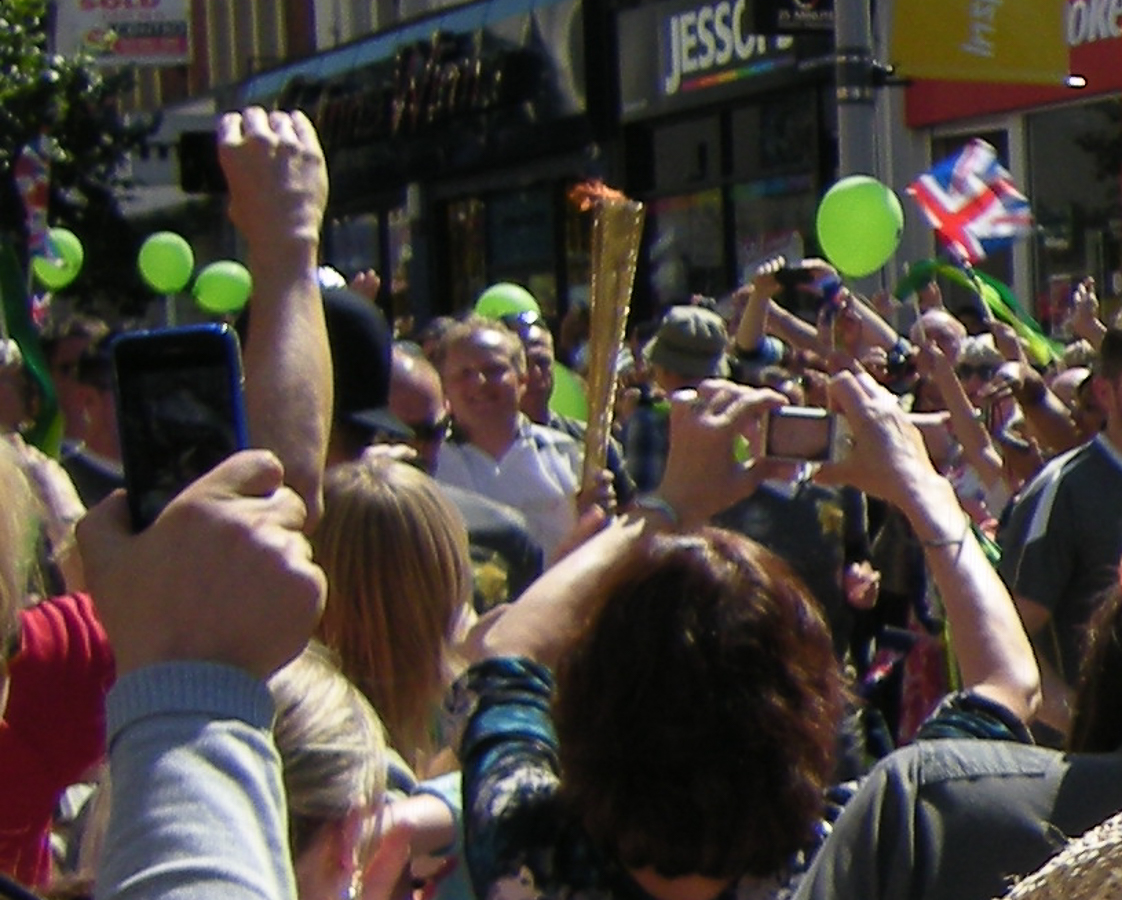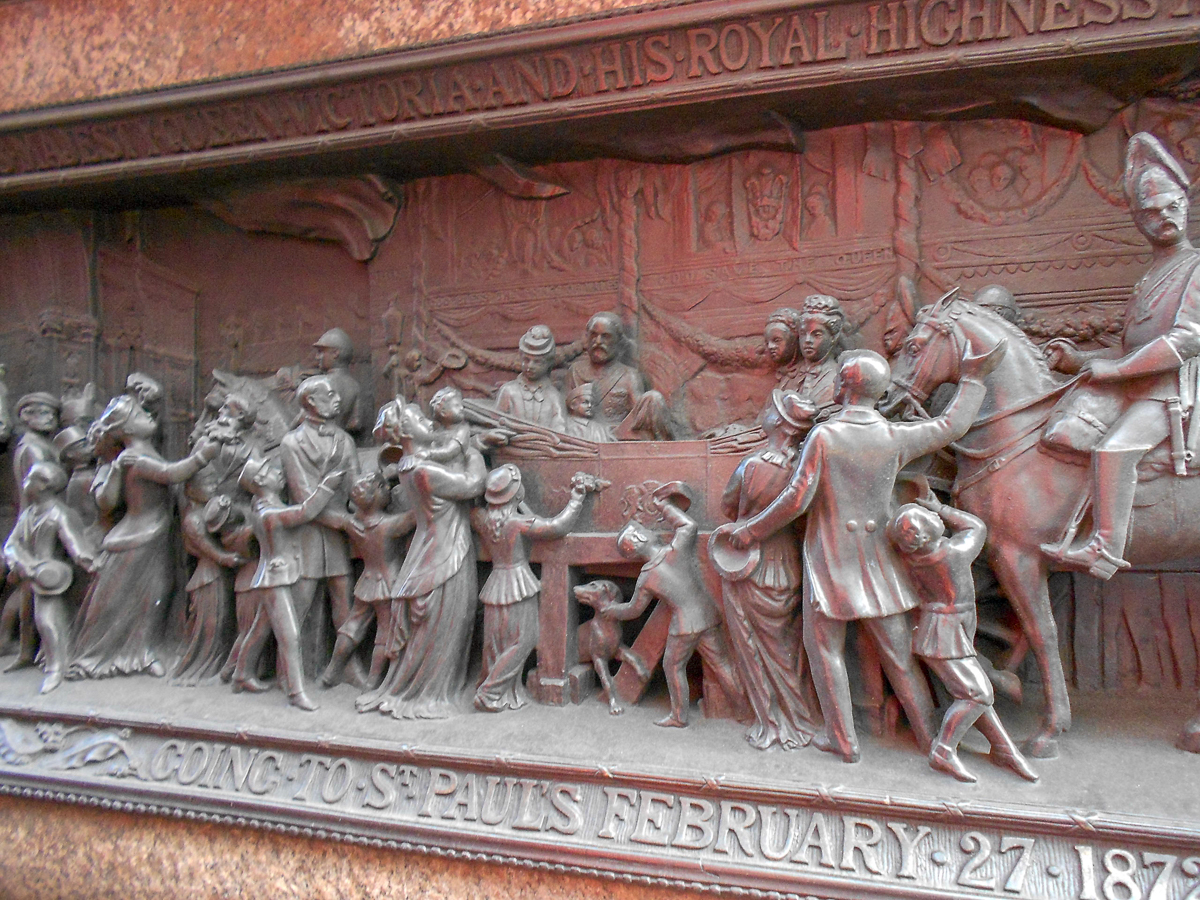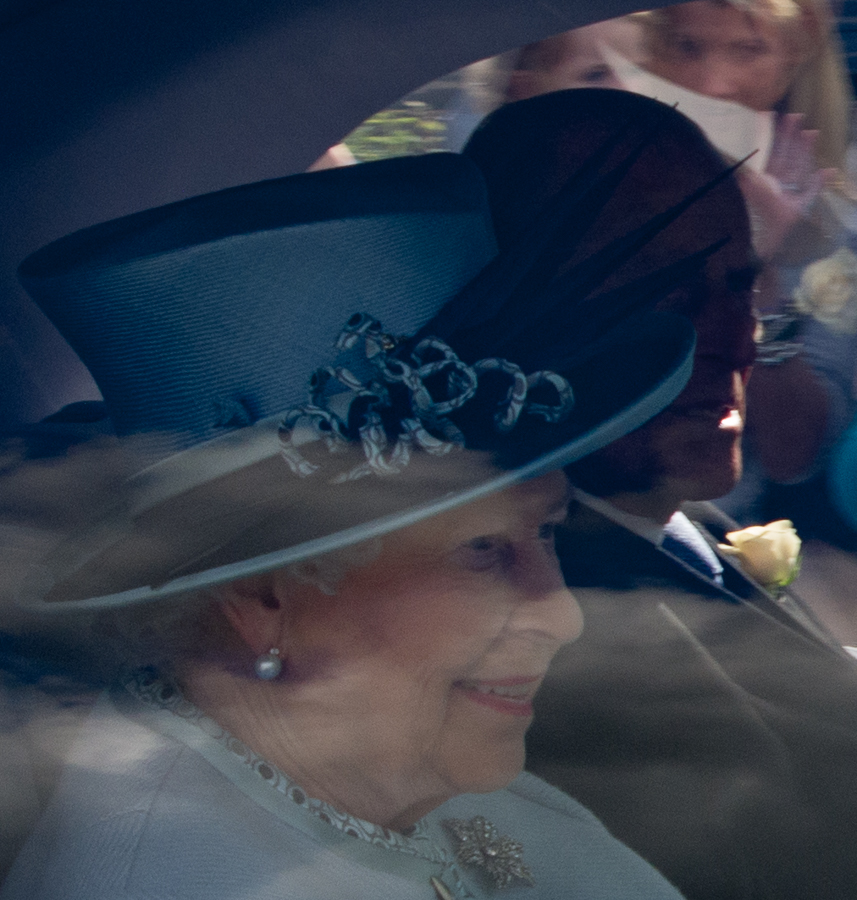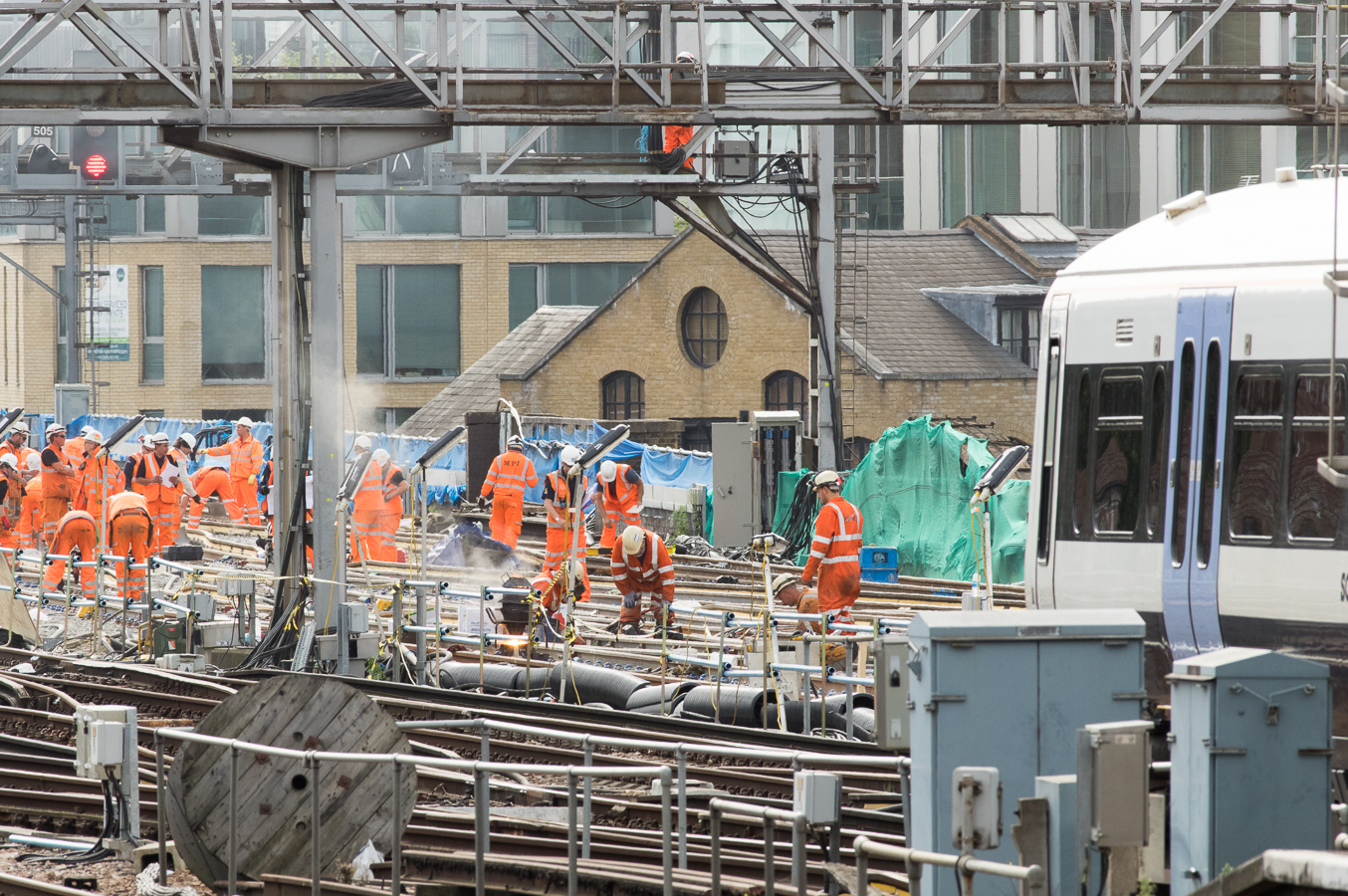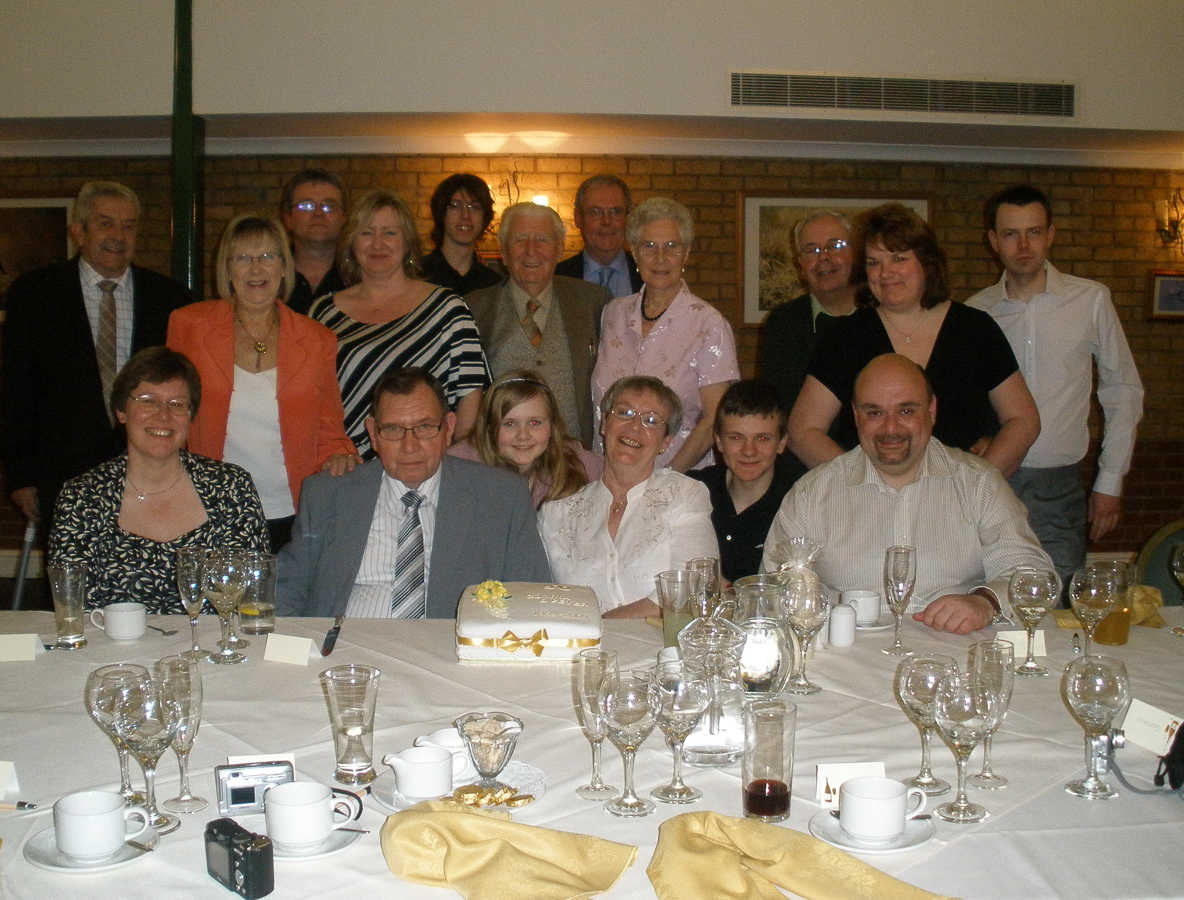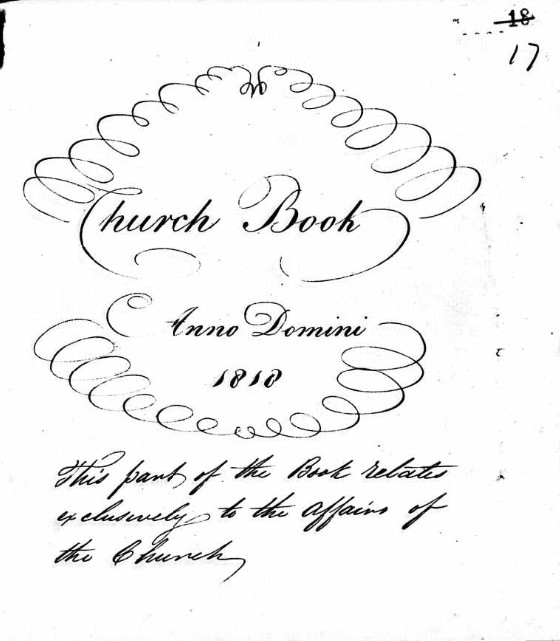..
Charles Henry New or Parker
Also known as Charles Henry New, Charles Henry Parker, and Charles Michael Parker, and Charles Henry Parker New.
The challenge here is to find if and when Parker became New.
Special thanks go to some of the Ancestry community who have done a lot of the heavy lifting for this, including AjHampshire1971, SueParkerHampshireUK, ange1bailey, and parkerfluengandy. Presumably all relatives.
Charles Henry New
The registration card below is about 55 years after 1886. Or 1941. The USA joined WWII officially on December 11, 1941. The Registration Card could be either before or after that date, but is probably something to do with it.

| Serial number; | U2921 | |
| 1 | Name; | Charles Henry New |
| 2 | Place of Residence; | 216 E Base Line, San Bernardino, California |
| 3 | Mailing Address; | Same |
| 4 | Telephone; | |
| 5 | Age in Years / Date of Birth | 55, July 1 1886 |
| 6 | Place of Birth | Southampton, England |
| 7 | Name and address of person who will alway know your address | Mrs Charles New, 216 E Base Line, San Bernardino, California |
| 8 | Employer's Name and Address | McNeil Construction Co |
| 9 | Place of Employment or Business | Las Vegas, Clark County, Nevada |
Did Charles become New on entry to the USA?
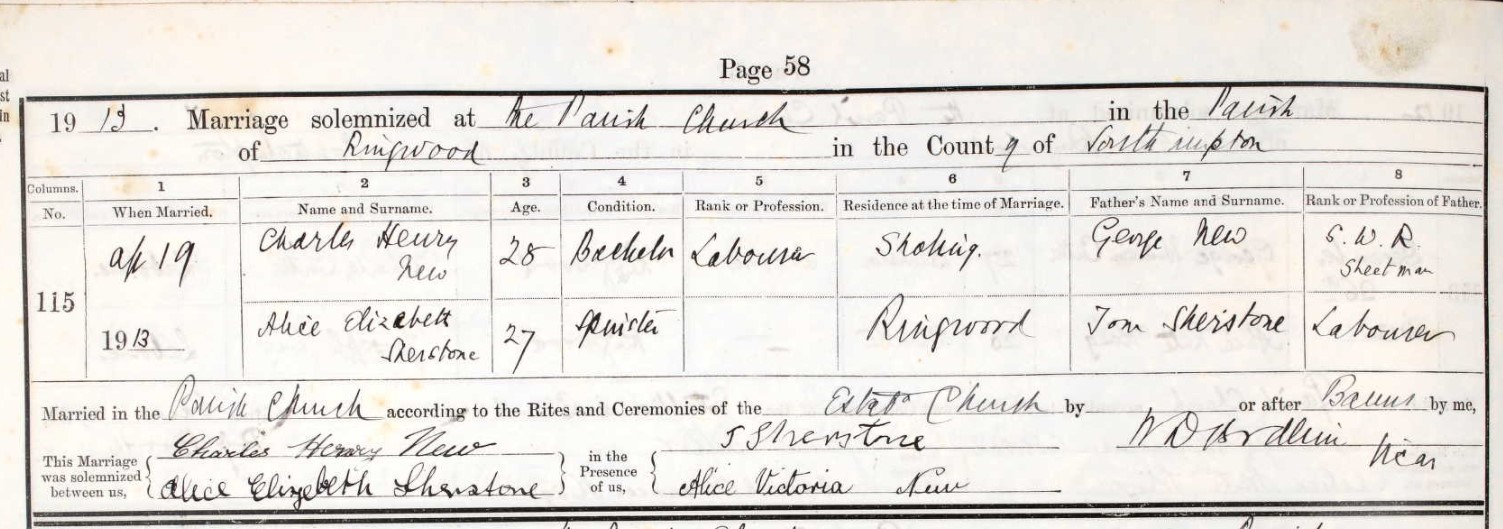
1913 Marriage solemnized at the Parish Church in the Parish of Ringwood in the County of Southampton [Hampshire]
No 115 April 19 1913
Charles Henry New, age 28, Bachelor, a Labourer from Sholing whose father George New, a S.W.R [South Western Railway] sheetman
married
Alice Elizabeth Sherstone, age 27, Spinster, from Ringwood whose father Tom Sherstone was a Labourer
Married in the Parish Church according to the Rite and Ceremonies of the Estabd [Established] Church by or after Banns by me ????? Vicar
This marriage was solemnized between us, {Charles Henry New Alice Elizabeth Sherstone} in the Presence of us {T Sherstone, Alice Victoria New}
All parties could write their name
CHURCH OF ST PETER AND ST PAUL, MARKET PLACE, RINGWOOD
Grade II* Listed
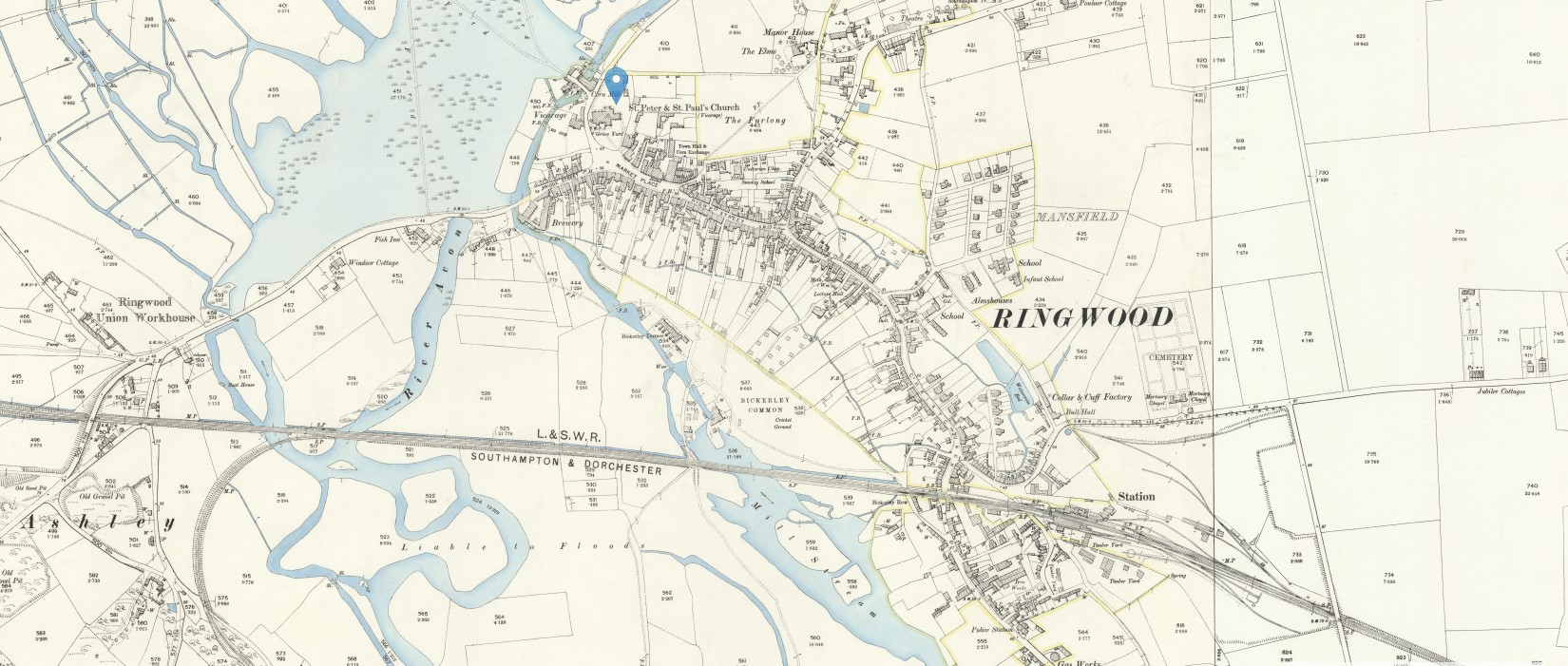 Hampshire and Isle of Wight LXX.11, Revised: 1896, Published: 1897 - NLS OS 25 Map Ringwood Parish Church
Hampshire and Isle of Wight LXX.11, Revised: 1896, Published: 1897 - NLS OS 25 Map Ringwood Parish Church
So, if this is the same person he was married under the name New. Also mentioned, George New and Alice Victoria New.
After marriage it appears that they moved to where Charles Henry New was in residence at the date of the marriage, Sholing, Hampshire, which is now part of the City of Southampton.
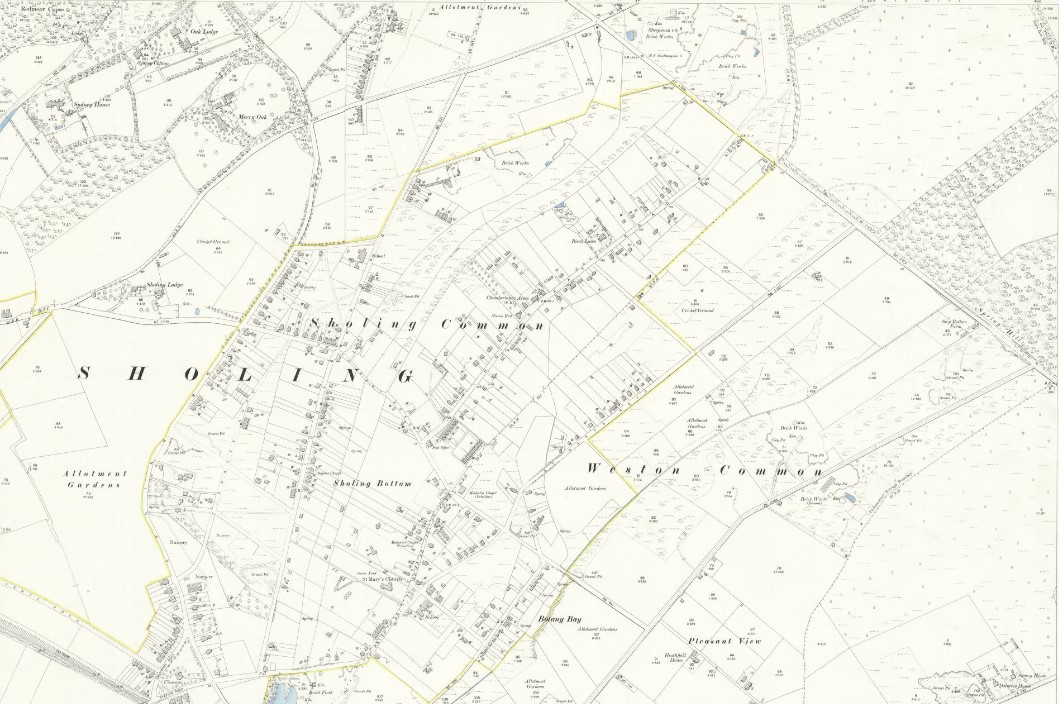 Hampshire and Isle of Wight LXV.12, Revised: 1895, Published: 1897 - NLS OS Map 25 Sholing
Hampshire and Isle of Wight LXV.12, Revised: 1895, Published: 1897 - NLS OS Map 25 Sholing
The family then moved to the USA in 1920, after the Great War, WWI.
Burden 11,146 gross
Built Shipowner or operator 1907 at Glasgow by Fairfield Shipbuilding & Eng. Co. Ltd. - Cunard Line
Dimensions 525.8ft x 60.2ft
Manifest of Alien Passengers for the United States Immigration Officer at Port of Arrival
on board the SS Royal George, Passengers sailing from Southampton Mar 30 1920, arriving New York Apr 10 1920.
Master, William Prothero. Surgeon, Edward Middleton.




| 1 | No. on List | |||||
| 2 | HEAD-TAX STATUS (This column for use of Government officials only) |
|||||
| 3 | Name in Full | |||||
| Family Name | New | New | New | New | New | |
| Given Name | Charles Henry | Alice Elizabeth | Tom Henry A | George Charles V | Agnes Alice Mary | |
| 4 | Age | |||||
| Years | 37 | 35 | 4 | 2 | 1 | |
| Months | 7 | 10 | 7 | 6 | 5 | |
| [Estimated birth] | SEP 1882 | OCT 1884 | SEP 1915 | OCT 1917 | NOV 1918 | |
| [Actual Date of Birth] | 3 OCT 1886 | 23 APR 1886 | 10 JUL 1915 | 10 AUG 1917 | 30 SEP 1918 | |
| 5 | Sex | M | F | M | M | F |
| 6 | Married or Single | M | M | S | S | S |
| 7 | Calling or Occupation | Labourer | H'wife | Student | Child | Child |
| 8 | Able to | |||||
| Read | Yes | Yes | Yes | No | No | |
| Read what Language [or if exception claimed on what ground]. |
English | English | English | Infant | Infant | |
| Write | Yes | Yes | Yes | No | No | |
| 9 | Nationality [Country of which citizen or Subject]. |
England | England | England | England | England |
| 10 | Race or People | England | England | England | England | England |
| 11 | Last Permanent Residence | |||||
| Country | England | England | England | England | England | |
| City or Town | Sholing | Sholing | Sholing | Sholing | Sholing | |
| 12 | The name and complete address of nearest relative or friend in country whence alien came |
Mother, Mrs A New, 398 ? Cedar St. Riverside, Cali |
||||
| 13 | Final destination | |||||
| State | Cali [California] | Cali [California] | Cali [California] | Cali [California] | Cali [California] | |
| City or town | Riverside | Riverside | Riverside | Riverside | Riverside | |
| 14 | No on List | 4 | 5 | 6 | 7 | 8 |
| 15 | Whether having a ticket to such final destination |
Yes | Yes | Yes | Yes | Yes |
| 16 | By whom was passage paid? | Mother | ||||
| 17 | Whether in possession of $50, and if less, how much? | Yes | ||||
| 18 | Whether ever before in the United States; and if so, when and where? | |||||
| Yes or No. | No | No | No | No | No | |
| If Yes -- | ||||||
| Year or period of years, | ||||||
| Where? | ||||||
| 19 | Whether going to join a relative or friend; and if so, what relative or friend, and his name and complete address. | Mother, Mrs A New, 398 ? Cedar St. Riverside, Cali |
||||
| 20 | Purpose of coming to United States. | |||||
| Whether alien intends to return to country whence he came after engaging temporarily in labouring pursuits in the United States. | No | No | No | No | No | |
| Length of time alien intends to remain in the United States. | Perm | Perm | Perm | Perm | Perm | |
| Whether alien intends to become a citizen of the Unites States. | Yes | Yes | Yes | Yes | Yes | |
| 21 | Ever in prison or ??? or institution for the cure and treatment of the insane, or supported by charity, if so, which? | No | No | No | No | No |
| 22 | Whether a polygamist. | No | No | No | No | No |
| 23 | Whether an anarchist. | No | No | No | No | No |
| 24 | Whether a person who believes in or advocates the overthrow by force or violence of the Government of the United States or all forms of ??? | No | No | No | No | No |
| 25 | Whether coming by reason of any offer, solicitation, promise, or agreement, expressed or implied, to Labour in the United States | No | No | No | No | No |
| 26 | Whether alien had been previously deported within one year | No | No | No | No | No |
| 27 | Condition of health, mental and physical. | Good | Good | Good | Good | Good |
| 28 | Deformed or crippled. Nature, length of time, and cause. | No | No | No | No | No |
| 29 | Height | |||||
| Feet | 5 | 5 | -- | -- | -- | |
| Inches | 8 | |||||
| 30 | Complexion | Sllw [sallow] | Pale | -- | -- | -- |
| 31 | Color of -- | |||||
| Hair. | Lgt [light] | ?? | -- | -- | -- | |
| Eyes. | Brown | ?? | -- | -- | -- | |
| 32 | Marks of identification | None | None | None | None | None |
| 33 | Place of birth | |||||
| Country | England | England | England | England | England | |
| City or town. | Sholing | Sholing | Sholing | Sholing | Sholing | |
Alice Elizabeth New was pregnant during the crossing to the USA as Frederick Louis New was born on 14 Aug 1920, just 4 months after landing in New York.
Charles Henry New states his Mother's address was 398 ? Cedar St. Riverside, California, although I can't be sure of the number on Cedar Street from the Passenger List. The address in Question 12 was meant to be, in this case in England. Perhaps as his mother was already in the USA, that is why the entries have been struck through. Perhaps not on the Alien List.
Where is Riverside? Near Los Angeles
A note from somebody on Ancestry.
When Charles Michael Parker was born in December 1860 in Southampton, Hampshire, his father, James, was 27 and his mother, Louisa, was 25. He married Agnes Ellen Kimber in December 1883. They had two children during their marriage. He died on February 10, 1926, in Southampton Hampshire England, at the age of 65. Agnes left Charles and lived with and had children by George New but I can't find a divorce from Charles Michael or a marriage to George New. I am descended from their eldest son James William who stayed with Charles Michael, his brother Charles Henry went with their Mum Agnes who eventually moved to riverside, California Charles Michael worked as a plasterer before he became ill in the last 19 years of his life.
This is an interesting take on the situation.
Charles Michael Parker and Charles Henry Parker
Charles Michael Parker
Charles Michael Parker was baptised on 24 Jan 1861 in Southampton Hampshire
Census 1861
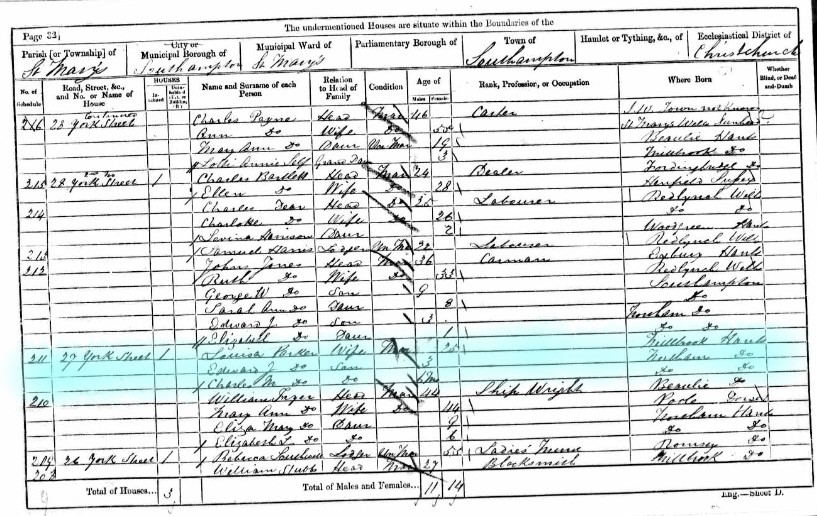
Census for St Mary's Parish in 1861.
27 York Street, St Mary's, Southampton, Louisa Parker as Head, and Wife, Married, Female aged 25 born in Millbrook Hampshire.
Resident on the day of the Census with two sons, Edward J, aged 3 and Charles M, aged 6 months, both born in Northam, Hampshire.
I belive York Street was renamed Evens Street, which is shown on the Old OS 25" map below.
 Hampshire and Isle of Wight LXV.12, Revised: 1895, Published: 1897 -- OS 25 Map York Street Evens Street, St Mary's Soton
Hampshire and Isle of Wight LXV.12, Revised: 1895, Published: 1897 -- OS 25 Map York Street Evens Street, St Mary's Soton
Evans Street is coloured yellow. It is very close to St Mary's Church. Evans Street still exists, but as part of a duel carriageway, no semblance to 1861, or 1895.
However, in the 1861 Census York Street is flanked by Clarence Street, George Street, and Millstone Point. A search for Millstone Point reveals another York Street. It is not a surprise that one of the York Streets had a change of name.
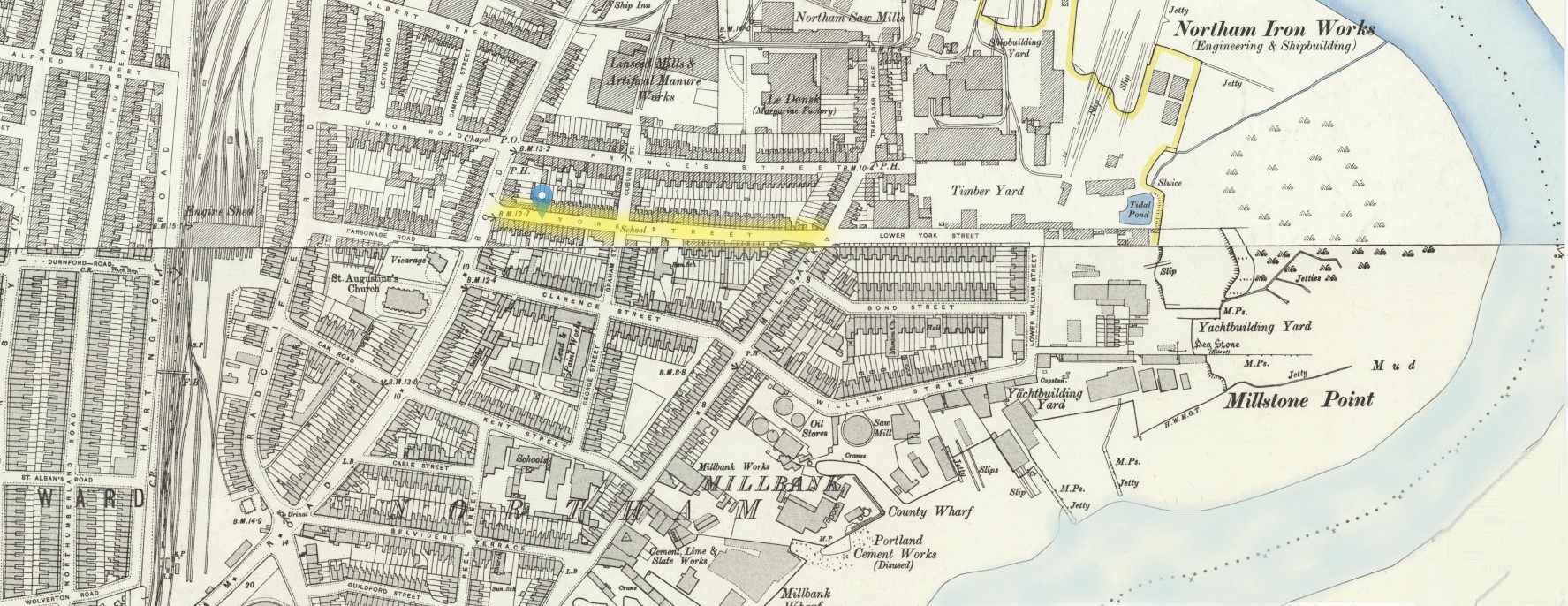 Hampshire and Isle of Wight LXV.7, Revised: 1895, Published: 1897 - OS 25 Map York Street, Northam, Southampton
Hampshire and Isle of Wight LXV.7, Revised: 1895, Published: 1897 - OS 25 Map York Street, Northam, Southampton
This matches with the children being born in Northam. The area has been redeveloped now, so no image of the old house.
However, this was found, posted on Ancestry by a relative of Charles Henry ???. It may be an extract from a book called Southampton's Lost Streets. I have a copy covering St Mary's and Golden Grove. There may be another covering this area.
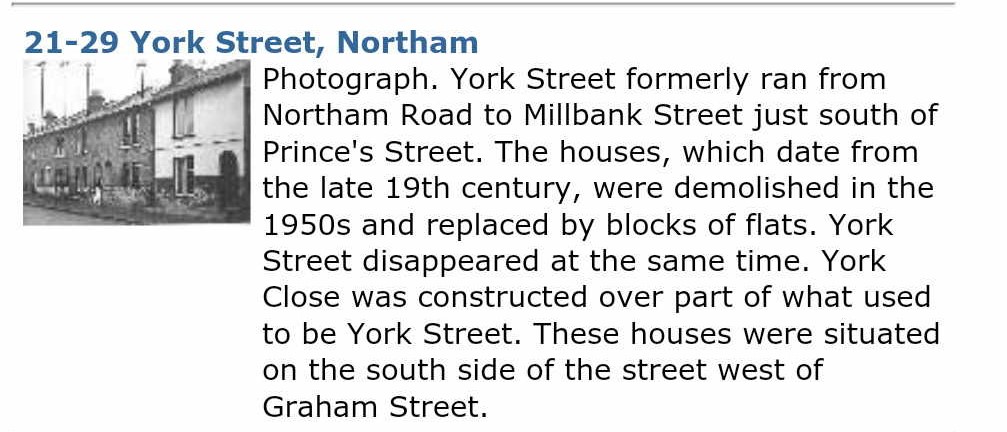
Marriage of Agnes Ellen Kimber's Parents, Frederick Henry Kimber and Alice Bessant, 1861

1861 Marriage solemnized at St Mary's Church in the Parish of North Eling in the County of Southampton
No. 141. Nov 23rd 1861
Frederick Henry Kimber, aged 21, a Bachelor, profession, Groom, residence Bartley. Father Henry Kimber, a Bailiff.
Alice Bessant, aged 20, a Spinster, residence Bartley. Father William Bessant, a Labourer
Married in the Church at North Eling according to the Rites and Ceremonies of the Established Church after banns by me George N. Phillips, Vicar.
This Marriage was solemnized between us, { Frederick Henry Kimber - Alice Bessant }
In the Presence of us, { Henry Bessant - Elizabeth Kimber }
All parties could sign their own name.
Their residence of Bartley is 4.2 miles, a one and a half hour walk away, from St Mary's Church, via Eling Tide Mill. Perhaps it was the local parish church of Alice. Although there is another possibility which is discussed in Locations below.
Census 1871

Census for St Denys Parish and Village in 1871.
26 Adelaide Road, St Denys, Southampton, Louisa Parker as Head, and Wife, Married, Female aged 35, recorded as Fireman's Wife born in Hampshire.
Resident on the day of the Census with children;
- Edward James, son, aged 13 years,
- Charles Michael son, aged 10 years,
- William Ambrose, son, aged 8 years,
- Emma Louisa, daughter, aged 6 years,
- Benjamin Walter, son, aged 3 years,
All single and born in Hampshire. All scholars apart from the 3 year old.
Together with Brother in Law, Frederick Gover, aged 14, also born in Hampshire and a scholar.
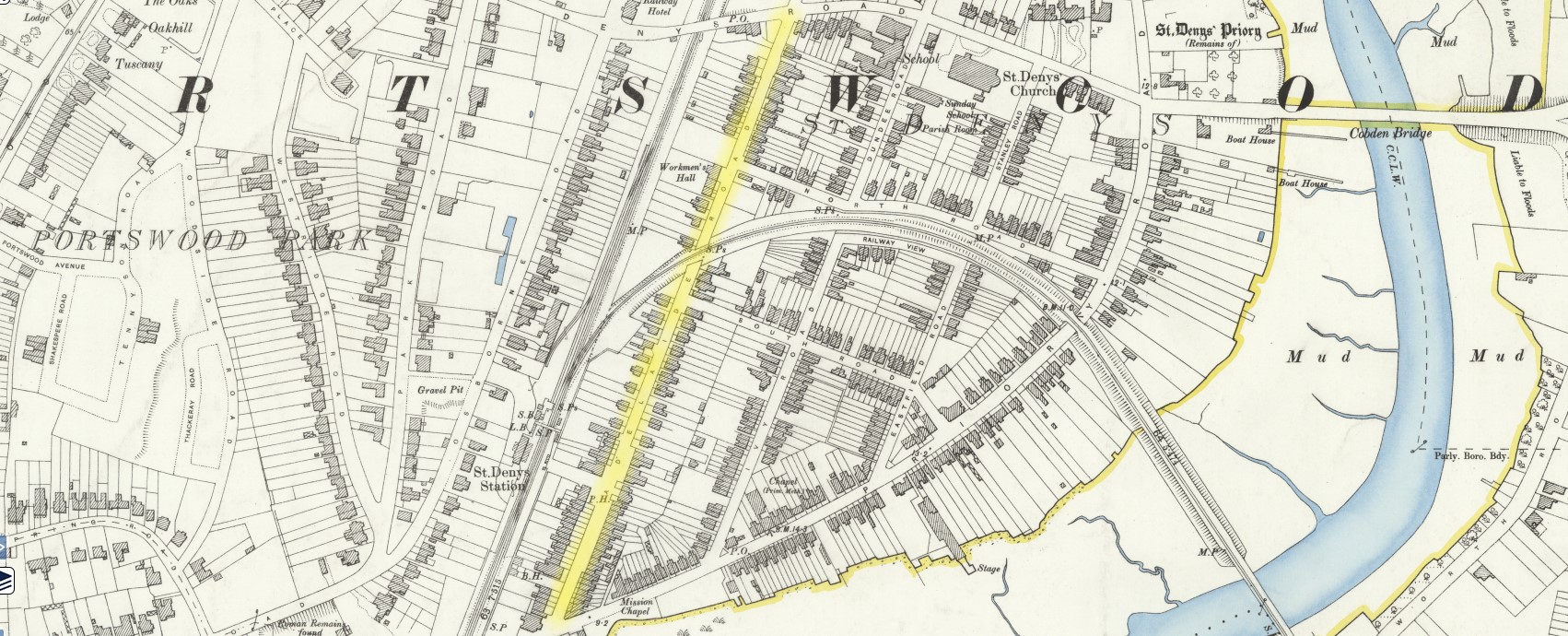
27 Adelaide Road, St Denys, Southampton, Hampshire. The Census has the family living at 26. No 27 in the image below is not necessarily the actual house as the numbers could have changed, but it is likely to be similar. They may be of the right age. The ones on the other side of the road are more modern. In the census, the numbers are sequential, did he walk along one side and then the other, or cross from side to side? The census list starts from North Street at no 1 Adelaide Road to no 88 where South Street is mentioned.then Eastfield Road.
Census 1881

Census for the Civil Parish of South Stoneham, Church Parish of St Deny's
82 Adelaide Road, Charles Parker. a boarder, unmarried male, aged 20, recorded occupation as a Plasterer, born in Northam, presumably, Hampshire.
Charles Michael Parker was born in 1861 and baptised on 24 Jan 1861 which would fit with him being 20 for this Census.
Marriage 1883

1883 Marriage solemnized at St Denys the Parish Church in the Parish of South Stonham in the County of Southampton [Hampshire]
No 175 October 27th 1883
Charles Michael Parker, age 23, Bachelor, a Plastorer from St Denys whose father James Parker, a Maritime
married
Agnes Ellen Kimber, age 21, Spinster, from St Denys whose father Frederick Kinber was a Coachman
Married in the Church of St Denys according to the Rite and Ceremonies of the Established Church by or after Banns by me ????? ????.
This marriage was solemnized between us, {Agnes Ellen Kimber and Charles Michael Parker} in the Presence of us {Mary Kimber, William John Pennery}
All parties could write their name.
One of the witnesses, William John Pennery, is very similar to Pomeroy!
Birth of children
Birth Records

Born Seventh August 1884 at Adelaide Road, St Deny's, South Stoneham, James William, a Boy to father, Charles Michael Parker and mother Agnes Ellen Parker formerly Kimber, father's occupation, a Plasterer. Notified by A. E. Parker, Mother, Adelaide Road, St Deny's, South Stoneham on the Twenty first August 1884 by Edward Messum, Registrar.

Born First July 1884 at Adelaide Road, St Deny's, South Stoneham U.S.D., Charles Henry, a Boy to father, Charles Michael Parker and mother Agnes Ellen Parker formerly Kimber, father's occupation, a Plasterer (Journeyman). Notified by A. E. Parker, Mother, Adelaide Road, St Deny's, South Stoneham on the Third August 1886 by Edward Messum, Registrar.
I believe that U. S. D. is an abbreviation for Urban sanitary districts, areas in towns with existing local government bodies. Sometimes a combination of Poor Law Union and Sanitary District.
South Stoneham is a large registration district in southern Hampshire. See UK BMD. The parish of Portswood, which was created 1894 out of the part of the parish of South Stoneham in Southampton County Borough. Later the parishes of Portswood and Shirley were reallocated to Southampton Registration District on 1st July 1909. South Stoneham Registration District was abolished on 1st April 1927.
The map on the link, Southampton Parishes shows Portswood as part of Southampton West, and is much larger than the current parish of Portswood.
The current address for Charles Henry Parker place of birth would be 27 Adelaide Rd, St Denys, Southampton SO17 2HU, although the house number a suggestion from other records.
Births registered

Parker, Charles Henry, S. Stoneham 2 c. 64, Q3 1886.
This registration and the above copy of the GRO Birth Certificate match for Charles Henry Parker.
Census 1891
A move to Jarrow?

The Jarrow March of 5–31 October 1936 was a long time in the future at the time of the 1891 Census, however, it is still somewhat strange for a plasterer to go from Southampton to go to Jarrow as a Shipyard Joiner. However, the names match, as do the places of birth. Bitterne and Botley are close together and would be acceptable for a Census match.
Census for Jarrow in the County of Durham 1891.
29 Blackett Street, Jarrow, Durham, Charles Parker as Head, married, male aged 28, recorded as Shipyard Joiner born in Sholing, Hampshire.
with
Agnes Parker, Wife, married female, aged 27, born in Bitterne, Hampshire
Resident on the day of the Census one child;
- Charles H, son, aged 2 months, single and born in Jarrow, Durham
Charles H Parker was therefore born in 1891 at Jarrow.
Now for something different.
A Census for a street just a short distance south of York Street.


Census 1891 for St Mary Southampton
4 Belvidere Terrace, St Mary's, Northam, Southampton, George New, married, male aged 30, recorded as a Railway Porter, born in Andover, Hampshire.
with
Agnes New, Wife, married, aged 27, born in Ealing Hampshire
Resident on the day of the Census with children;
- Charles New, son, aged 4 years, born in St Denys
- Agnes New, daughter, aged 4 years, born in Southampton
- Alice New, daughter, aged 1 month, born in Southampton
All single and born in Hampshire.
Estimated years of birth;
- George New 1861
- Agnes New 1864
- Charles New 1887
- Agnes New 1888
- Alice New 1891
All the above Census 1891 copied to the George Charles New section, to begin a new line of enquiry!
Census 1901

Census for St Mary's, Northam, Southampton, in 1901.
50 Radcliffe Road, St Mary's, Southampton, Charles M Parker as Head, Married, Female aged 40, recorded as Plasterer born in Southampton, Hampshire.
Resident on the day of the Census with a child;
- James W, son, aged 16 years, single, worker in Engineering shop, and born in Southampton, Hampshire.
Charles M Parker appears without a wife at this time.
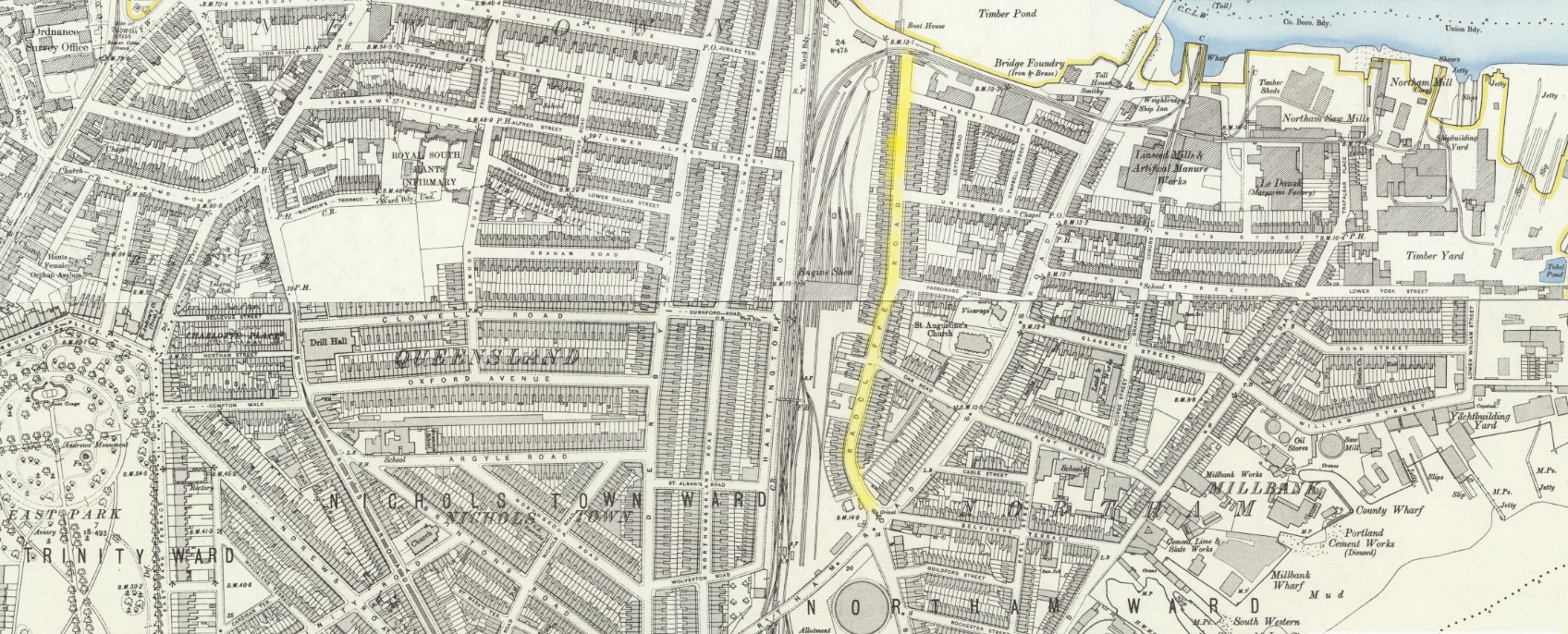
Has the family split up?

Census 1901 the parish of Sholing
2 Kitchener Terrace, Butt's Road, Sholling, St Mary Extra, Hampshire, England
2 Kitchener Terrace ?? St Mary Extra, Southampton, Agnes Parker as Head, Widowed, Female aged 37, recorded as being employed in House Keeping born in Botley, Hampshire.
Resident on the day of the Census with children;
- Charles Parker, son, aged 15 years, single, worker [possibly ??? Farm], and born in St Denys, Hampshire.
Other children;
- Alice New, daughter, aged 10, single, born in Northam, Hampshire
- George New, son, aged 5, single, born in Shirley, Hampshire
- Pearl New, daughter, aged 2, single, born in Eastleigh, Hampshire
From the places of birth of the children, Agnes has moved around a lot in the last twenty years if you include James W, living with his father in the other 1901 Census above. Southampton, St Denys, Northam, Shirley. and Eastleigh. All in the vicinity of Southampton.
Agnes also tells the Enumerator for the Census that she is a Widow, which I don't believe is true as he appears to be living at 50 Radcliff Road on the same day as she states he is dead. Agnes is still surname Parker, so presumably has not yet remarried. At a guess I would say that she is living with a man as if they were married with the surname New, and at this stage they have had three children together who remain alive at the date of the 1901 Census.
Agnes Ellen Kimber, age 21 according to the Marriage certificate of 1883. 1901 is 18 years after marriage, so would equate to Agnes Ellen Parker being 39 years of age. Age 37 on the 1901 Census is well within the tolerances of ages found in the Census records.
Charles Michael Parker, age 23, according to the Marriage certificate of 1883. 1901 is 18 years after marriage, so would equate to Charles Michael Parker being 41 years of age. Age 40 on the 1901 Census is well within the tolerances of ages found in the Census records.
Sholing and Botany Bay had a proportion of itinerant people living in the area at the time, which may have made it easier to blend into the shadows of society, if that is what they were trying to do.
Census 1911
No. |
Section |
Place of abode |
Estimate of commencement
|
Estimate of finish
|
|
| 1 | England |
Southampton, Hampshire |
Baptism - 1861 |
||
| 2 | England |
27 York Street, St Mary's, Northam, Southampton |
Census 1861 |
|
|
| 3 | England |
26 Adelaide Road, St Denys, Southampton |
Census 1871 |
|
|
| 4 | England |
|
Census 1881 |
|
|
| 5 | England |
St Denys, Southampton |
Marriage 1883 |
|
|
| 6 |
|
Census 1891 |
|
||
| 7 |
|
Census 1901 |
|
||
| 8 |
|
Census 1911 |
|
||
| 9 |
|
|
|
||
| 10 |
|
|
|
||
| 11 |
|
|
|
||
| 12 |
|
|
|
||
| 13 |
|
|
|
||
| 14 |
|
|
|
||
George Charles New
George Charles New
Census 1891
Now for something different.
A Census for a street just a short distance south of York Street.


Census 1891 for St Mary Southampton
4 Belvidere Terrace, St Mary's, Northam, Southampton, George New, married, male aged 30, recorded as a Railway Porter, born in Andover, Hampshire.
with
Agnes New, Wife, married, aged 27, born in Ealing Hampshire
Resident on the day of the Census with children;
- Charles New, son, aged 4 years, born in St Denys
- Agnes New, daughter, aged 3 years, born in Southampton
- Alice New, daughter, aged 1 month, born in Southampton
All single and born in Hampshire.
Estimated years of birth;
- George New 1861
- Agnes New 1864
- Charles New 1887
- Agnes New 1888
- Alice New 1891
 Hampshire and Isle of Wight LXV.10, Revised: 1895, Published: 1897 - OS 25" Map York Street and Belvidere Terrace Northam
Hampshire and Isle of Wight LXV.10, Revised: 1895, Published: 1897 - OS 25" Map York Street and Belvidere Terrace Northam
Locations
Locations
Places and locations of significance to this article gathered together in one place.
Southampton and area
Southampton has grown considerably over time. Accordingly some places that were separate villages, or even open space, are now absorbed into the town/brough and now city of Southampton.
St Mary's church is close to the old walled town of Southampton, and is therefore part of the core. Portswood, Northam, and St Denys are all further out but are in the same area with some overlapping.
St Mary's
Portswood
Northam
St Denys
{\tabs-CHNlocSoton}
Bartley
Their residence of Bartley is 4.2 miles, a one and a half hour walk away, from St Mary's Church, via Eling Tide Mill. Perhaps it was the local parish church of Alice. Although there is another possibility which is discussed in Locations below.
Continued
Ringwood
Jarrow
Sholing
Sholing, Bitterne, Hampshire
Domesday Book
There appears to be no mention of Sholing in the Domesday Book, at least in that form of spelling. However there is an entry for Hound.
Hound was a settlement in Domesday Book, in the hundred of Mansbridge and the county of Hampshire.
It had a recorded population of 23 households in 1086, putting it in the largest 40% of settlements recorded in Domesday (NB: 23 households is an estimate, since multiple places are mentioned in the same entry).
The image is an extract of the Domesday Book, fortunately transcribed for us.
Land of Hugh of Port
Households
Households: 31 villagers. 9 smallholders. 6 slaves.
Land and resources
Ploughland: 9 ploughlands. 3 lord's plough teams. 6 men's plough teams.
Other resources: Meadow 20 acres. 2 mills, value 1 pound. 1 church.
Valuation
Annual value to lord: 14 pounds in 1086; 8 pounds when acquired by the 1086 owner; 14 pounds in 1066.
Owners
Tenant-in-chief in 1086: Hugh of Port.
Lord in 1086: Hugh of Port.
Overlord in 1066: King Edward.
Lords in 1066: Wulfric; Wulfward.
Other information
This entry mentions multiple places: Hound; Warnford.
Phillimore reference: Hampshire 23,18

The map marks the location of Hound from the Domesday Book entry, and the suburb of Sholing in the modern Southampton. Hound is not the nearest dot on the map. Netley and Woolston, also have entries.
Netley was a settlement in Domesday Book, in the hundred of Mansbridge and the county of Hampshire.
It had a recorded population of 13 households in 1086.
Land of Richard Poynant
Households
Households: 9 villagers. 2 smallholders. 2 slaves.
Land and resources
Ploughland: 5 ploughlands. 1 lord's plough teams. 2 men's plough teams.
Other resources: Meadow 4 acres. Woodland 40 swine render. 1 church.
Valuation
Annual value to lord: 5 pounds in 1086; 2 pounds when acquired by the 1086 owner; 3 pounds in 1066.
Owners
Tenant-in-chief in 1086: Richard Poynant.
Lord in 1086: Richard Poynant.
Overlord in 1066: King Edward.
Lord in 1066: Alward.
Other information
Phillimore reference: Hampshire 42,1
Woolston was a settlement in Domesday Book, in the hundred of Mansbridge and the county of Hampshire.
It had a recorded population of 6 households in 1086, putting it in the smallest 40% of settlements recorded in Domesday.
Land of Reginald (Cnut)
Households
Households: 3 villagers. 3 smallholders.
Land and resources
Ploughland: 1 men's plough teams.
Valuation
Annual value to lord: 5 shillings in 1086; 10 shillings in 1066.
Owners
Tenant-in-chief in 1086: Reginald (Cnut).
Lord in 1086: Reginald (Cnut).
Overlord in 1066: King Edward.
Lord in 1066: Tovi.
Other information
Phillimore reference: Hampshire 59,1
The abbey of Netley
The abbey of Netley, Letley (Lœtus Locus), or Edwardstow (Loci Sancti Edwardi), dedicated to the honour of the Blessed Virgin and St. Edward the Confessor, was founded for Cistercian monks by Henry III. in 1239. It appears that Peter des Roches, Bishop of Winchester (1205-38), purchased the land of ' Hanseta ' and ' Cedrigia' from William, Bishop of Angers, and the dean and chapter of Angers; lands in Wellow from the abbot of St. Mary de Pratis, Leicester; lands at Kingston Deverel from the bishop and chapter of Le Mans; land called 'Ayhsleg' in Dorsetshire from the abbot of Croix St. Leufroy; and some other parcels of land, apparently with the object of founding this monastery. The bishop, however, died in 1238, before the completion of his object, and the actual foundation was carried out by Henry III. in the following year. Hence the king was usually referred to as the founder. So soon as the monastery was completed it was colonized by monks from the Cistercian abbey of Beaulieu, who arrived at their new home on St. James' Day, 1239.
In August, 1243, Roger de Clare sold to the abbey for 300 marks the tilled land and pasture which lay between their manor of Gomshall and the highway from Guildford to Dorking, and also the advowson of the church of Shere, which grant was confirmed by John de Warren, Earl of Surrey, in 1252.
In 1244 Innocent IV. sanctioned Under certain conditions the appropriation by the abbey of Netley of the churches of Shere and Wellow, valued at £30 per annum. The same pope in the following year confirmed to the abbot and convent of Netley the privileges of not being compelled by bishops or others to attend synods or assemblies outside their order, save only pro fide, and of exemption from sentences of excommunication, suspension or interdict.
In the same year Robert, abbot of Netley, released to the Bishop of Winchester the manor of Esher, with the advowson of the church and all its appurtenances, save 100s. worth of land in Dorsetshire. In August, 1247, the abbot and convent of Lieu Dieu, in the diocese of Amiens, sold to the abbey of Netley for 600 marks their English manor of Nordley, their rents in Oxford, their rents and rights in Chaddleworth and their rent of five marks from the church of Henton.
Henry III. on 7 March, 1251, confirmed to Netley Abbey (Sancte Marie de Loco Sancti Edwardi) the site of the monastery with the lands of Netley, Hound, Wellow, Totton, Gomshall, Nordley, Kingston Deverel, Waldon, Aynsley and Lacton, with rents in Charleton, Southampton and Southwark, a hundred acres in Shere manor and the church there, as well as many liberties and privileges. A fortnight later the king granted to the abbey free warren on their lands in Netley, Hound, Shotteshale, Westbrook and Sholing (Hants), Waddon and Aynsley (Dorset), and Gomshall and Shere (Surrey), a weekly market at Hound on Monday and a two days' fair at Wellow on the vigil and day of St. Margaret. Henry III. continued his benefactions to the abbey, and on 24 July, 1253, granted to it three carucates of land, of 100 acres each, in the New Forest, with licence to enclose and cultivate them; and in 1256 he gave special licence to enclose the same against the king's deer. He also further granted to the abbey a tun of wine yearly out of the prisage at Southampton, to be used for the celebrations in the abbey. Edward I. instructed the taker of the king's wines at Southampton in 1276, 1277 and 1280 to duly supply this wine according to the late king's charter; but in 1281 Edward I. granted 20s. yearly in alms in lieu of the wine, as the prisage at Southampton was assigned to Eleanor, the king's mother, as part of her dower.
... (jumping forward a few centuries)
A royal commission was issued in 1535, which empowered Thomas, abbot of Forde, to visit various Cistercian houses, including Netley and all those of Winchester diocese.
The Valor of 1535 estimated the gross revenue of Netley Abbey at £160 2s. 9½d., whilst the clear income was only £100 12s. 8d.; it therefore came under the heading of the lesser monasteries. Being of exempt jurisdiction, no particulars are given in the return.
On 30 May, 1536, Sir James Worsley and his brother commissioners presented their report on the religious houses of Hampshire. Netley is described as 'A hedde house of Monkes of thordre of Cisteaux, beinge of large buyldinge and situate upon the Ryvage of the Sees. To the Kinge's Subjects and Strangers travelinge the same Sees great Relief and Comforte.' The commissioners estimated its total revenues at £181 2s. 8d. They found there seven monks, all priests, ' by Raporte of good Religious conversation, whereof desieren to Contynne Religiar vj, and to have capacite j.' There were thirty-two other inmates, namely ' ij freeres observantes comytted by the Kinge's highnes,' four waiting servants, four officers of the household, eleven officials of the convent, seven hinds and three ' for the dayery.' The church, mansions and buildings were in good repair. The lead and bells were worth £57; plate and jewels, £43 2s. 11d.; ornaments, £39 4s. 8d.; stuff, £9 3s. 4d.; corn, £10 17s.; stocks and stores, £103 13s. 4d. The woods were worth £81. The debts of the house were £42 3s. 4d., but there was £28 5s. owing to the house.
The abbey of Netley retained most of its early endowments, and at the time of its dissolution the lands belonging to it were, besides the site, the manors of Wellow, Totton, Roydon, Nordley, Gomshall, Kingston Deverel and Hound; and lands and possessions in Southampton, West Setley, Mitcomb Regis, Charleton, Shottishale, Sholinge and Shamelhurst.
On 3 August, 1536, the king gave to Sir William Poulett, the comptroller of his household (two of whose brothers had been the commissioners who reported so favourably of this house in the previous May), the site and buildings of the suppressed abbey, together with the grange, mill and lands in Netley; the manor of Hound; lands and windmill, etc., in Hound and Sholing; the manor of Townhill; lands, etc., in Townhill and Shamelhurst; and the manor of Waddon and the farm of Aisheley in Dorsetshire. The manor of Kingston Deverill (Wilts) was bestowed on Sir Edward Seymour in the following year. The reversion and rent reserved upon a lease granted in 1502 by Abbot John Burges of the manor of Gomshall, Surrey, was given in 1538 to Sir Edward Braye. The tithes of Wellow rectory and land there were granted in 1539 to Sir Richard Lyster, chief baron.
The English Reformation
The English Reformation took place in 16th-century England when the Church of England broke away from the authority of the Pope and the Roman Catholic Church. These events were, in part, associated with the wider European Protestant Reformation, a religious and political movement that affected the practice of Christianity in western and central Europe. Causes included the invention of the printing press, increased circulation of the Bible and the transmission of new knowledge and ideas among scholars, the upper and middle classes and readers in general. The phases of the English Reformation, which also covered Wales and Ireland, were largely driven by changes in government policy, to which public opinion gradually accommodated itself.
The break with Rome was affected by a series of Acts of Parliament passed between 1532 and 1534, among them the 1534 Act of Supremacy, which declared that Henry was the "Supreme Head on earth of the Church of England" (this title was renounced by Mary I in 1553 in the process of restoring papal jurisdiction; when Elizabeth I reasserted the royal supremacy in 1559, her title was Supreme Governor). Final authority in doctrinal and legal disputes now rested with the monarch; the papacy was deprived of revenue and the final say on the appointment of bishops.
Another view of the English Reformation
Dissolution of the Monasteries (and Abbeys)
The Reformation in Tudor England was a time of unprecedented change. One of the major outcomes of the Reformation was the destruction of the monasteries which began in 1536.
The Reformation came about when Henry VIII wished to divorce his first wife, Catherine of Aragon, who had failed to give him a male heir. When the Pope refused to grant the divorce, Henry set up the Church of England. The Act of Supremacy in 1534 confirmed the break from Rome, declaring Henry to be the Supreme Head of the Church of England.
The monasteries were a reminder of the power of the Catholic Church. It was also true that the monasteries were the wealthiest institutions in the country, and Henry’s lifestyle, along with his wars, had led to a lack of money. Monasteries owned over a quarter of all the cultivated land in England. By destroying the monastic system Henry could acquire all its wealth and property whilst removing its Papist influence.
The idea was not new. Thomas Cromwell had already helped Cardinal Wolsey dissolve monasteries in the past. First of all, a dossier was presented to Parliament outlining the corrupt morals of the clergy. Henry’s chief minister Cromwell then introduced the ‘Valor Ecclesiasticus’ to find out just how much property was owned by the Church. He sent out royal commissioners to all the monasteries in England, Wales and Ireland.
This led to the Act of Suppression in 1536 whereby small monasteries with an income of less than £200 a year were closed and their buildings, land and money taken by the Crown. The Second Suppression Act of 1539 allowed the dissolution of the larger monasteries and religious houses.
Monastic land and buildings were confiscated and sold off to families who sympathised with Henry’s break from Rome. By 1540 monasteries were being dismantled at a rate of fifty a month.
After the disposal of their monastic lands and buildings, the majority of monks, friars and nuns were given money or pensions. However, there were some abbots and religious house leaders who refused to comply. They were executed and their monasteries destroyed. Thousands of monastic servants suddenly found themselves without employment.
A bit circuitous, but it appears that from the initial growth and spread of influence following Netley Abbey's creation, upon the dissolution of the Abbey, Sholing came under the control of Sir William Poulett,
Shortly after the Dissolution of Netley Abbey, we have Saxton's map of Hampshire, 1575. Below is a extract.
 Extract from Christopher Saxton Map - Map, hand coloured copper plate engraving, Southamtoniae, ie Hampshire, scale about 4 miles to 1 inch, engraved by Leonard Terwoort, Antwerp, Netherlands, published by Christopher Saxton, map maker, London? about 1575
Extract from Christopher Saxton Map - Map, hand coloured copper plate engraving, Southamtoniae, ie Hampshire, scale about 4 miles to 1 inch, engraved by Leonard Terwoort, Antwerp, Netherlands, published by Christopher Saxton, map maker, London? about 1575
Hound and Netley are shown as well as Bitterne, but Sholing is not on the map yet.
 Map, hand coloured copper plate engraving, Hantshire described and divided, Hampshire with part of the Isle of Wight, and a town plan of Winchester, scale about 4 miles to 1 inch, by John Speed, engraved by Jodocus Hondius, about 1611. Published in the Theatre of the Empire of Great Britain, 1611.
Map, hand coloured copper plate engraving, Hantshire described and divided, Hampshire with part of the Isle of Wight, and a town plan of Winchester, scale about 4 miles to 1 inch, by John Speed, engraved by Jodocus Hondius, about 1611. Published in the Theatre of the Empire of Great Britain, 1611.
The administrative districts called Hundreds are shown on this 1611 map. Hound and Netley are in Mansbridge Hundred, which appears to be in three separate sections, whilst Sholing, which would be between Bitterne and Itchen are in Waltham Hundred. Click on the map to go to the larger source map for greater clarity.
 These notes are made from a '1 inch to 1 mile' map of Hampshire surveyed by Thomas Milne, published by William Faden, 1791. The item used is in the Map Collection of Hampshire CC Museums Service, item HMCMS:FA1998.124.
These notes are made from a '1 inch to 1 mile' map of Hampshire surveyed by Thomas Milne, published by William Faden, 1791. The item used is in the Map Collection of Hampshire CC Museums Service, item HMCMS:FA1998.124.
We can rely on Milne's 1791 Map to provide more detail. Hound is shown, as are Netley, Castle, Netley Abbey, Netley Green, Netley Lodge, and Netley. Family seats, or Estates are also shown with the name of the owner. Sydney Farm for instance is annotated The Honourable Mrs Yorke. Sholing, whilst in the vicinity of Sydney Farm, still does not receive a mention.
 These notes are made from a 1 inch to 1 mile map of Hampshire surveyed by C and J Greenwood and N L Kentish, published by Greenwood and Pringle and Co, 1826. The item used is in the Map Collection of Hampshire CC Museums Service, item HMCMS:FA1965.589 - Southampton
These notes are made from a 1 inch to 1 mile map of Hampshire surveyed by C and J Greenwood and N L Kentish, published by Greenwood and Pringle and Co, 1826. The item used is in the Map Collection of Hampshire CC Museums Service, item HMCMS:FA1965.589 - Southampton
Still no Sholing on Greenwood's 1826 version of Hampshire.
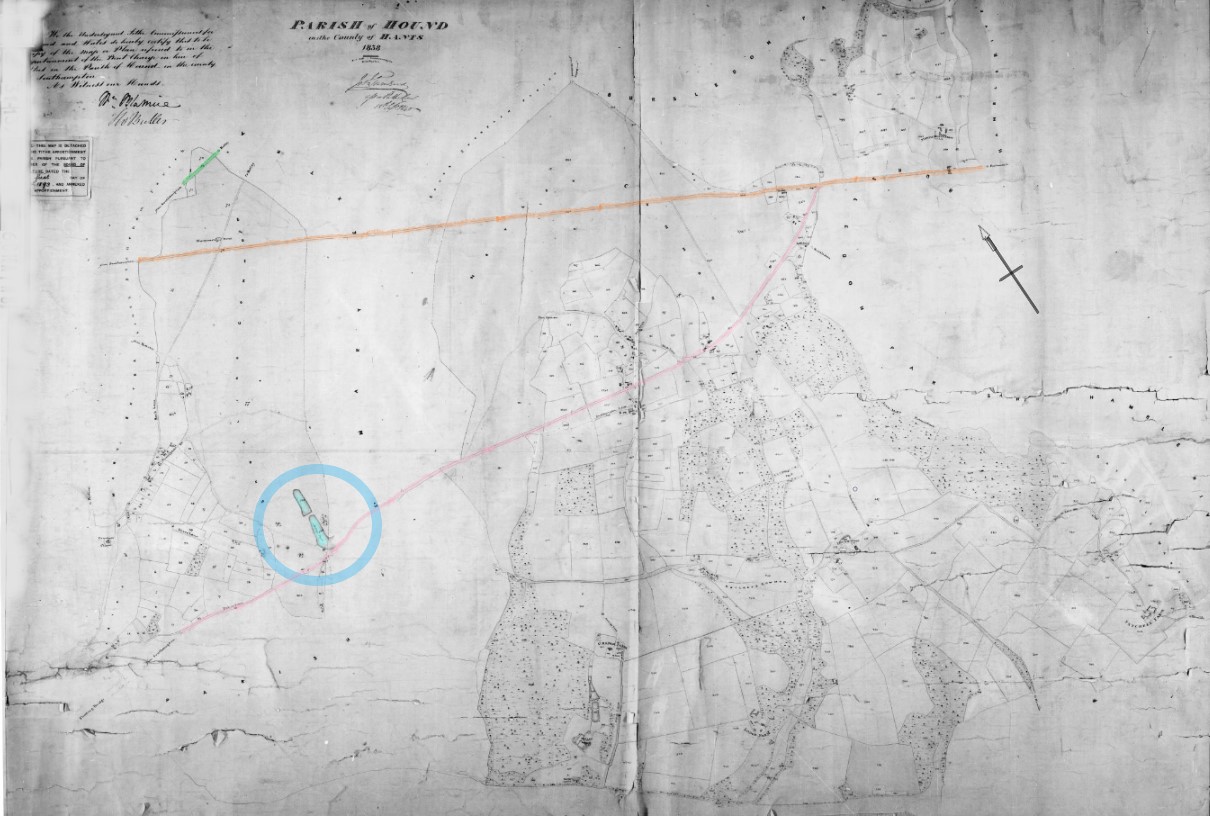 Tithe Map of the Parish of Hound near Southampton
Tithe Map of the Parish of Hound near Southampton
The first recognisable part of the Tithe map of the Parish of Hound, Hampshire was Millers Pond, which fortunately was named on the map and the apportionment, circled in blue. It is a different shape however form the same named pond on the later Ordnance Survey 25" Map. I believe that this can be explained. Hover over the map to zoom in. The brown wash area is the Parish of St Mary's Extra. Millers Pond on the map starts to curve upwards, but it enters another parish and the drawing on the pond is not completed. The additional pond north of Millers pond could have been filled in.
 Extract of Parish of Hound Tithe Apportionment with Sholing Roads and Commons
Extract of Parish of Hound Tithe Apportionment with Sholing Roads and Commons
There are a number of roads listed in the Parish of Hound Tithe Apportionment in the Tithing of Sholing, Roads and Commons, in particular;
| Plot | Description | Colour wash |
|---|---|---|
| 18 | Part of Itchen Lane and New Turnpike Road | Pink |
| 73 | Turnpike Road to Botley | Green |
| 76 | Portsmouth Turnpike Road | Brown |
| 80 | New Turnpike Road through Sholing Common | Pink |
| 84b | New Turnpike Road to Portsmouth | Pink |
| 109a & b | Southampton and Portsmouth Turnpike Road | Brown |
| 423 | Turnpike Road Near Bursledon Bridge | Brown |

The colour wash refers to the additional colour lines added to the tithe map to indicate the Turnpike Roads crossing the parish. The light green area on the zoom in map, hover over with a mouse, is Sholing Common. Itchen Lane is shown on the route of the New Turnpike Road. Sholing Lane, towards the top left of the map in red wash. The New Turnpike Road is presumably to serve the Itchen Floating Bridge, also shown on the main map.
South Stoneham Registration District
- Registration County : Hampshire.
- Created : 1.7.1837.
- Abolished : 1.4.1927 (to become part of Eastleigh registration district).
- Sub-districts : Millbrook, St. Mary Extra, South Stoneham.
- GRO volumes : VII (1837-51), 2c (1852-1927).
A lot of my close Family History is based around Hampshire, and in particular the South Stoneham Registration District. Records frequently stating South Stoneham, which from the above table by Brett Langston it is evident covers a large area, as well as the village of South Stoneham. Hover over the map of the Parishes of Hampshire to zoom into the parishes around South Stoneham.

Onward to 1840s, and OS Old Series Hampshire 1810 (revised). Southampton has a dock and the railways have arrived. Sholing, circled in red, has arrived on a map.
 These notes are made from the first edition, Old Series one inch to one mile maps of Hampshire surveyed by the Ordnance Survey, Tower of London, London, published in the 1810s. The maps used are mostly later editions mostly from the 1840s, and are in the Map Collection of Hampshire CC Museums Service
These notes are made from the first edition, Old Series one inch to one mile maps of Hampshire surveyed by the Ordnance Survey, Tower of London, London, published in the 1810s. The maps used are mostly later editions mostly from the 1840s, and are in the Map Collection of Hampshire CC Museums Service
Sydney Farm appears to be Sydney House and Ridgeway, Ridgeway Castle, but no owners shown. Botany Bay also makes a appearance, between Sholing Common and Netley Common.
 Ordnance Survey Map Southampton (Outline), Sheet 315, Revised: 1893, Published: 1895 - Marker at Sholing
Ordnance Survey Map Southampton (Outline), Sheet 315, Revised: 1893, Published: 1895 - Marker at Sholing
In 1893, it is evident from the one inch map above that Sholing is still predominantly rural and not yet absorbed into a suburb of Southampton. The address would therefore be Sholing, Hampshire, or Sholing, Bitterne, Hampshire, in the registration district of South Stonham.
 Hampshire and Isle of Wight LXV.12, Revised: 1895, Published: 1897 - Sholing Common
Hampshire and Isle of Wight LXV.12, Revised: 1895, Published: 1897 - Sholing Common
Change to a 25 inch OS Map and there is more detail to look at. The map seems to indicate that Sholing Common and Sholing Bottom are included the general area of Sholing, together with, potentially, at the very bottom of the map, Botany Bay. Click on the map to investigate further. Middle Road has a gravel colour wash.
Wikipedia also has an article about Sholing
In 1920, the village became part of the Borough of Southampton. Its history as a separate entity ended then.
USA
Eliss Island, New York, USA
Riverside, California, USA
San Bernardino, California, USA
USA
Calculations and Suppositions
Census 1901 supposition
It appears to me that the Census of 1901 for 2 Kitchener Terrace, Butt's Road, Sholing, Hampshire is the merging of two families, despite the absence of two men.
Putting both full families together, purely as conjecture, to see how it all looked together.
Starting with the Parker family, and then adding the New family from both 1891 and 1901 Census.
| Name | Not incl | Estimated Birth | Census Residence | Census Year | |
| 1 | Charles Michael Parker | X | 1901-40=1861 | 50 Radcliff Road | 1901 |
| 2 | Agnes Ellen Parker nee Kimber | 1901-37=1864 | 2 Kitchener Terrace | 1901 | |
| 3 | James W Parker | X | 1901-16=1885 | 50 Radcliff Road | 1901 |
| 4 | Charles Parker | 1901-15=1886 | 2 Kitchener Terrace | 1901 | |
| 5 | Charles H Parker | X | 1891-0=1891 | 29 Blackett Street, Jarrow | 1891 |
| 6 | George New | X | 1891-30=1861 | 1891 | |
| 7 | Agnes New | X | 1891-27=1864 | 1891 | |
| 8 | Charles New | X | 1891-4=1887 | 1891 | |
| 9 | Agnes New | X | 1891-3=1888 | 1891 | |
| 10 | Alice New | 1891-0=1891 | 2 Kitchener Terrace | 1901 | |
| 11 | George New | 1901-5=1996 | 2 Kitchener Terrace | 1901 | |
| 12 | Pearl New | 1901-2=1899 | 2 Kitchener Terrace | 1901 |
Two other suppositions that need to be explored.
- That Agnes Parker nee Kimber and Agnes New are different people despite name and year of birth similarities. The first was born in Botley / Bitterne, Hampshire, and the latter, Ealing, Hampshire. Both in the vicinity of Southampton, but one near the River Itchen, and the second, adjacent to the River Test.
- That Charles H Parker, born in 1891 in Jarrow, but died before 1886 when the name was reused for a son born in St Denys, Northam, Southampton, Hampshire That however is the wrong way around. Are there two Charles Parker in the family. Or is the 1891 Census not a match. With James (1885) and Charles (1886) not being with them in Jarrow, where are they? James is in Cardiff, Wales with his Grandmother in the 1891 Census, but Charles is yet to be accounted for.
So far I have not found any records to categorically prove these suppositions.
An alternative position is that Agnes was leading a double live with two families, just three streets apart, if ignoring the trip to Jarrow. Which currently I consider improbable.
DNA
DNA Matches
Notes from others
Notes found generally on Ancestry, which are relevant. The may have relationship references, which refer to the note maker, not to me.
AJ
Notes from a person on Ancestry who I shall refer to as AJ. I have added this person to my tree and established the relationship.
Charles Michael Parker
...
James William Parker
My Great Grandfather's birthday, 7th Aug
Prayer Book given for 10th Birthday from his aunt Mary
7th August 1894 • Southampton
Two days ago (17/12/2010) I Held the prayer book given to my great grandfather James William Parker on the 7th Aug 1894 for his 10th birthday.by his aunt Mary. lovely to have that connection, Mary was his father's sister aged 20 at the time.
[Birth year therefore 1884]
Census 1901
1901 • 50 Radcliffe Road, St Mary, Hampshire, England
James William Parker who is listed as 16 and employed at an engineering shop he is living with his Dad Charles M who is still employed as a plasterer, now they occupy two rooms in the house
Occupation
1910 • 27 Canal Walk, Southampton
In 1909 -1910 The photography Studio at 27 Canal walk was owned by H A Sinclair, by 1911 - 1912 also according to Kelly's J W parker was now the owner, so I assume he purchased it off Sinclair
{Some additions to the note my me.}
Historic Southampton Maps 1846, Canal Walk
Historic Southampton Maps 1846, 27 Canal Walk was between Union Street and College Street
14 Feb 1915 • Southampton, Hampshire, England, United Kingdom
His mother left to live in America with his half sister Pearl New
Residence
13 Sept 1918 • 27 Upper Canal walk, Southampton
Photographer also had studio at address, sadly he buried his daughter who died aged only 11 months on this day, at Holly brook cemetery he bought a family plot for her at Hollybrook Cemetery Southampton Grave Sect NO B 004 120. close to the chapel.
28 Aug 1920 • Southampton, Hampshire, England, United Kingdom
His brother Charles Henry left to live in America with his wife and young family, joining James's mother Agnes who went out in 1915.
Occupation
1921 • Southampton
Official photographer saints football club
Occupation
1924 • East Street bought "The Standard" cinema for £5,000 was previously known as the bug hutch but the refurbishment saw a new balcony and seating for 550 patrons
silent films were accompanied by a small orchestra
Occupation
1929 • 79 East St, Southampton City Centre
Still the owner of the "THE STANDARD", the front seats are benches the back are proper seats, a piano plays sound effects, during a war film the pianist had a drum to replicate the canon fire, the audience would cheer if our side did well.
Residence
10 June 1931 • Southampton, 63 Cranbury Avenue
Sadly buried his son Eric Godfrey aged only 8 months on this day
Residence
1937 • Wood Lodge Calmore Totton
Listed as living here on the marriage certificate for his son Charles James Parker still listed as CINEMA PROPRIETOR
Residence
1939 • Wood Lodge Calmore Totton
situated next to Shepherds Hey Copse, Harold used to climb the trees and crack nuts with his friend. He also helped his friend check the chickens in the nearby Poultry farm. The ponies would wander in the garden The Copse became housing in 1940's.
Occupation
1940 • Southampton, Hampshire, England
The Standard is closed following damage in the blitz, the building was sold to Edwin Jones whos own premises had been largely destroyed
Residence
1970 • Long Lane, Holbury
My Great Grandpa James bought a swiss cottage which had always been his wives dream, they lived on a plot in his daughter Mildred (Sis) Young nee Parker and her husband Arthur's garden, they ran a general store.
Death
1971 • New Forest, Hampshire, England
The year I was born, while my Mum was pregnant. I so wish I could have met him, I love photography and the old silent films, I just would adore talking to him
Cremation
23 Aug 1971 • Hollybrook Cemetery Southampton Grave Sect NO B 004 120 Int Number 042461
My Great Grandpa James was cremated and added to the plot he bought in 1918, for his child Phyllis Fanny who died aged 11 months, at the time of his death he was living in Holbury
Charles Henry Parker
...
SJ
...
Conclusion
